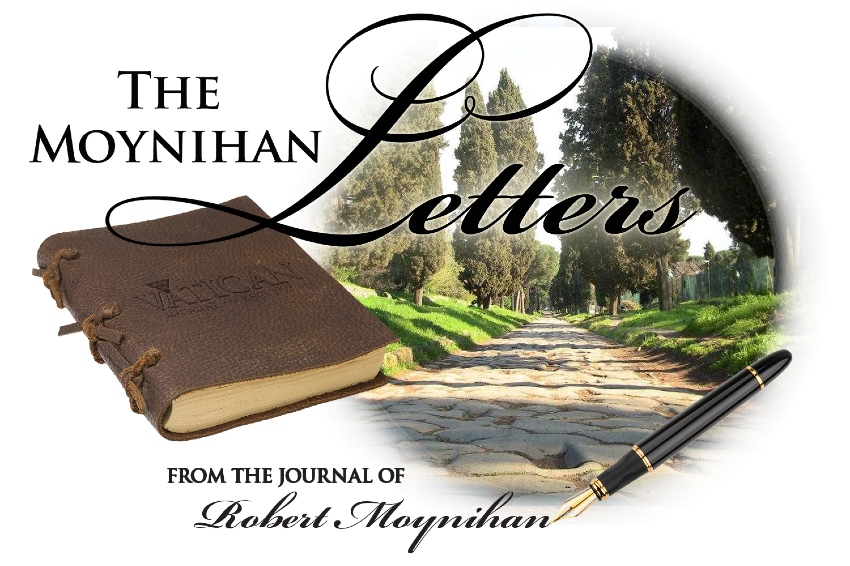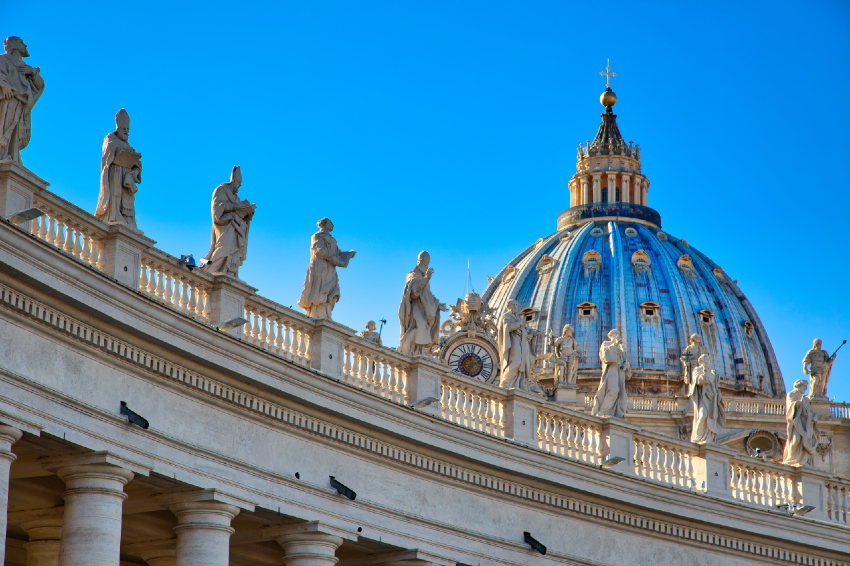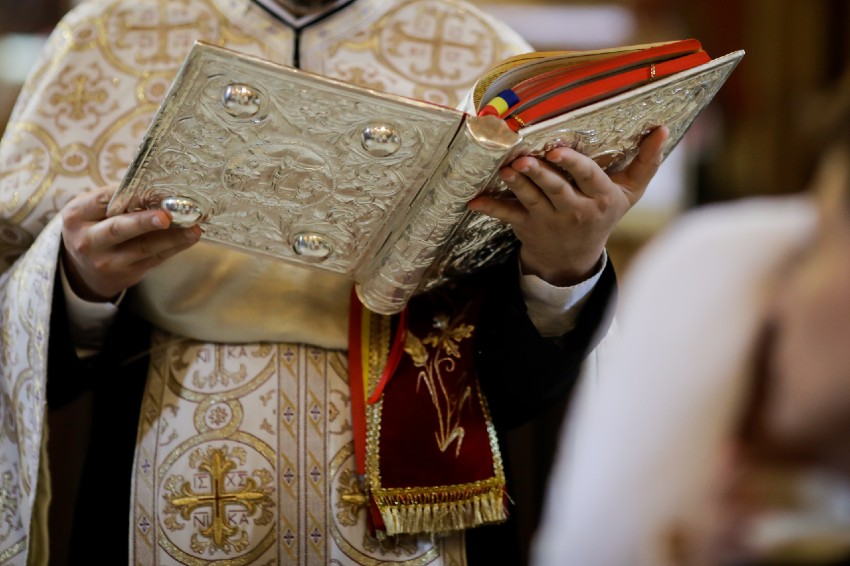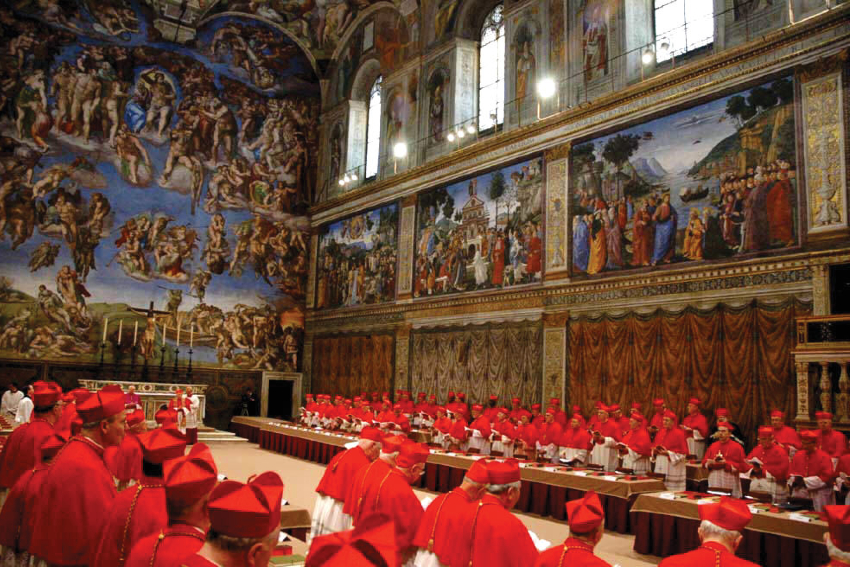
The Church of St. Nicholas of Tolentino, the Armenian church in Rome, in early April 2024. It is currently undergoing restoration
 The interior of the church during an Armenian rite liturgy
The interior of the church during an Armenian rite liturgy

Cardinal Gregory Peter XV Agagianian (1895-1971). Agagianian was elected at the age of 42, on November 30, 1937, during the reign of Pope Pius XI, on the first ballot, by a vote of six in favor and three against, to be the Catholicos-Patriarch of the Great House of Cilicia of Catholic Armenians — the head of the Armenian Catholic Church. But few know that later, in October 1958, when he was 63, Agagianian was almost elected head of the entire Roman Catholic Church(!) during the Conclave that elected Pope John XXIII. Agagianian’s election in 1958, had it occurred (because he was from central Asia), would have given great impetus to the cause of reunification between Rome and the Christians of the East, the consequence of which, arguably, would have been to present a more united and so more powerful Christian witness to the modern secular world, and its now-global agenda. There is underway a process for Agagianian’s beatification
“Choosing Agagianian meant giving the Church an Eastern Pope who could, for this reason, reunite Christianity.” —Cardinal Celso Costantini, on the eve of the October 1958 papal conclave at which Cardinal Gregory Peter XV Agagianian was a strong candidate, and almost won the election. Costantini, very old and held back by sickness, was unable to attend the conclave and cast his vote, but he wrote, on the eve of the conclave: “Therefore, in conclusion, my vote: for the election to the Supreme Pontificate I propose the Armenian Cardinal Peter XV Agagianian, the candidate who responds to the urgent needs of our time” (cited in the little book by Alessandra Scotto entitled “Servant of God Gregory Peter XV Agagianian,” 2023, Editrice Velar; Scotto writes “Most of the quotes are taken from the Historical Archive of the Pontifical Armenian College, Cardinal Agagianian Fund of Rome”)
“Do you know that your Cardinal and I had about the same number of preferences in the conclave last October? Our names alternated, now up, now down, like chickpeas in boiling water…” —Pope John XXIII, speaking on February 1, 1959, about the events of the October 1958 Conclave that elected him Pope, at the Armenian Pontifical College in Rome. Since this is first-hand testimony from one of the persons most closely involved in the events of the 1958 papal election, the testimony must be considered as of singular importance. The man Pope John was referring to as “your Cardinal” as he spoke to the Armenian seminarians was, of course, Cardinal Agagianian
“No servant is greater than his master, but every well-prepared disciple will be like his master: perseverance in faith, and a return to religious freedom… We believe that one day Russia will convert, and we priests, ministers and faithful strive to accelerate this day. We believe that there are also many people thirsty for God in Russia who are attached to the Christian traditions of their ancestors and to the veneration of the Great Mother of God.” —Cardinal Agagianian, in August of 1959, during a trip to Australia, speaking in Perth
Letter #8, 2024, Tuesday, May 7: Agagianian
Four weeks ago, on a crisp Sunday in April, walking in Rome, I happened upon a church I did not know.
With hesitation — for the place looked half-abandoned — I entered this unknown church… and I discovered one of the most beautiful liturgies in the Church, and found a little pamphlet on the life of Cardinal Gregory Peter XV Agagianian, and this led me to recall a little-remembered event in modern Church history which seems quite relevant to our present situation…
Hence this letter.
***
The church was high up at the top of a flight of 15 massive white (but now darkened with years of rain and smog) marble stairs.
I could see grass poking up out of the cracks in the stairs.
I wondered: is this an abandoned church?
I stood for a few seconds at the bottom, hesitating.
There was scaffolding across the facade and also what seemed to be white sheets up either side of the large white steps, as if to funnel climbers to the distant, central door.
I tried to discern whether the door was open, or shut — I didn’t want to walk up many steps only to discover I could not even go inside…
***
Special note: Join me and Fr. Charles Murr for our live podcast tomorrow, Wednesday, May 8, 2024 at 11:00 EDT. You can view this on YouTube at this link here or you can watch on Rumble here. The recording will be available at the same links after the live stream.
***
…An elderly couple walked up, and set their shoes on the first step. They seemed intent on climbing the whole way up the white stairs.
“Excuse me,” I said. “Could you tell me: is the church open?”
“Yes,” the man said, and the woman nodded. “We are going to Mass. It is starting now.” He paused. “It will be in Armenian, in the Armenian rite. This is the Armenian church in Rome.” A moment of silence. “We were born in Armenia.”
He paused again, and smiled. “You will be welcome if you decide to join us.”
“Thank you,” I said. “I will join you.”
And so I hastened with the two up the flight of white marble steps — it seemed longer and steeper than it appeared! but how could I be tired if this old couple could make the same climb, and with seeming ease? — until we reached the central door, and entered… another world.
It was the Church of St. Nicholas of Tolentino, up the hill from Piazza Barberini and down the hill from the American Embassy in Rome.
It is dated from 1606 — some four and a quarter centuries ago — when Father Agostino Maria of the Discalced Augustinian Fathers bought this plot of land, and erected two small chapels, on to the Madonna of the Rosary, the other to St. Nicholas of Tolentino.
But the present church was built, and it opened for worship on May 4, 2024 — exactly 400 years ago three days ago…
So I write this, as it were, on the 400th birthday of this church.
The chant and hymns of the Armenian liturgy transported me from the streets of Rome in 2024 to the mountain monasteries of Armenia in the early 300s, some 1,700 years ago… for the Armenian liturgy is one of the oldest, if not the oldest, continually celebrated liturgy in the Church, dating from the first years of the 300s.
And inside the church is a chapel dedicated to St. Gregory the Apostle of Armenia, also known as St. Gregory the Illuminator (257 to 328 A.D., link), which also contains the tomb of Cardinal Agagianian.
According to pious tradition, St. Gregory came to Rome and met with Pope Sylvester 1 in the time of the Emperor Constantine the Great.
And so my chance discovery of the Armenian Church led me to re-discover, and re-consider, the near-election as Pope of Cardinal Agagianian, head of the Armenian Church.
A blessed Orthodox Easter — which came this year on Sunday, May 5, just two days ago — to all.
(Next year, in 2025, the two Easters will fall on the same Sunday, April 20.)
As we proclaim in the Easter liturgy: “Christ is risen!” —RM
***
Note: You may wish to follow us on our new Locals channel, here. This is our new “community channel.”
If you would like to support this letter, and also our developing podcast and internet efforts, you may wish to make a small donation here.







Facebook Comments